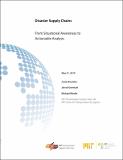Disaster Supply Chains: From Situational Awareness to Actionable Analysis
Author(s)
Boutilier, Justin James; Goentzel, Jarrod; Windle, Michael
Download053119-Disaster-Supply-Chains.pdf (6.491Mb)
Metadata
Show full item recordAbstract
Achieving situational awareness is insufficient when it comes to restoring private sector supply chains. More important than being aware of the current situation is correctly understanding interdependent supply chains, forecasting resources and flows, and knowing where and how to intervene with government assistance. Private sector organizations achieve supply chain visibility with enterprise resource systems. Achieving the same visibility across competing and decentralized private sector organizations will require a shift in how the emergency management community approaches cooperation and data aggregation. Accurate, timely, and representative data feeds are required for explanatory, forecasting, and prescriptive tools that should be used dynamically during disasters, not afterwards. Successful data aggregation strategies will require a mix of connecting to pre-existing data feeds and collecting information directly through creation of voluntary trusted spaces and mandatory
reporting requirements. Complex models that leverage optimization and machine learning can provide emergency managers with a better understanding of the causes and remedies of supply chain disruption. Models will take time and effort to develop and employ. Models should support, not replace, current information sources to enable better decision making. Improved communication between government and the private sector is critical for improved
disaster response. Collaboration between public and private sector actors will contribute to better information flow and help prioritize recovery efforts.
Date issued
2019-05-31Keywords
humanitarian, supply chain managament, hurricane response